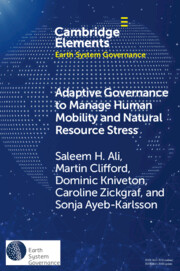Element contents
Adaptive Governance to Manage Human Mobility and Natural Resource Stress
Published online by Cambridge University Press: 10 January 2023
Summary
Keywords
- Type
- Element
- Information
- Online ISBN: 9781009357708Publisher: Cambridge University PressPrint publication: 09 February 2023
References
- 10
- Cited by

